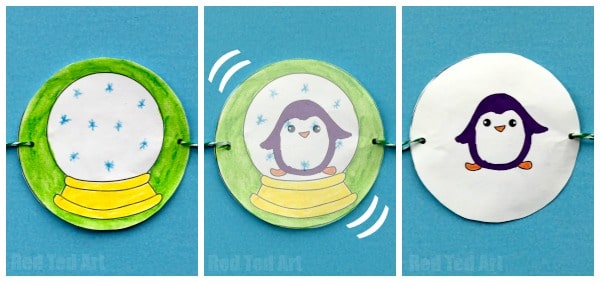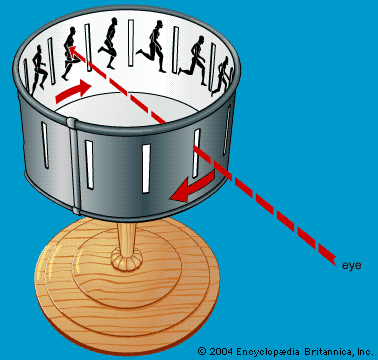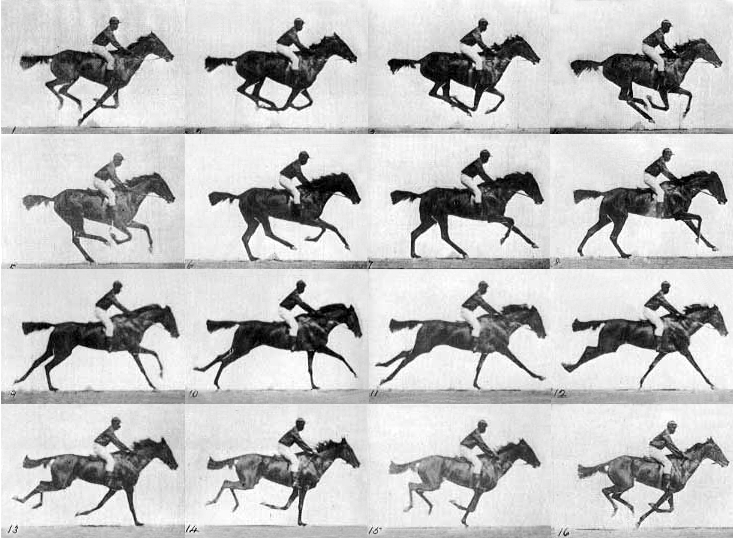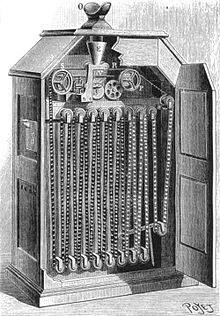Simplified Moving pictures History
All information is referenced from the resource in the BSA 106 class with tutor Vaughn with some new informationPersistence of Vision
This idea is what lead to most film, TV and animation's to be created and experimented with. This idea states that the human eye retains an image for a few seconds after the image is gone. So people thought that if the image that suddenly replaces the last image is sightly different, then it appears to be a moving picture/one image.
Making the Camera
People say that this was proven true with the Thaumatrope in 1825. This invention was a piece of paper with two different images on either side. Then the thaumatrope is spun, the images combine into one image.This was the first step to making moving images.

1) The images marge into one
Next come the Phenakistiscope made by Joseph Plauteau in (1831). The Phenakistiscope was the first widespread device that created moving pictures. What it did was spin a circle piece of cardboard with different images on it, and the viewer looked at the reflection in a mirror.

2) What would be seen from the Phenakistiscope




The Zoetrope made by William Horner in 1834 was origanly called the Daedalum, meaning Wheel of Death. The Zoetrope was basiclly a better version of the Phenakisticope. Horner's original invention was forgotten in 1867, when it was patented by M Bradley. Also when it was renamed by William Lincoln to The Zoetrope meaning Wheel of Life. 3)

4) You view the image through the little slides as it moves
Next came the Praxinoscope made by Charles-Emile Reynaud in 1877. This invention was made to better the viewing size and quality by having inventor mirror inside the bowl as the images spun around the center. Instead is looking though a tiny slide with the Zoetrope, the viewer would look at the images in the mirrors. The Praxinoscope was popular in Paris until the Lumiere brother's movies started.

5) The long strips with different images lined the inside of the bowl.
The next big step in animation history was when Eadweard Muybridge proved that all the hooves of the horse when running leave the ground in 1872. He set up a series of cameras along the track that would take photos of the horse and horse rider running. The were triggered to take the photo by a trip wire network.

6) People believed that he was right about the horses after these photos
Cameras at the time were improving a lot at that time but in 1882, Scientist Etienne-Jules Marley created and used the Chronophotographic gun that took 12 photos per second. This was when motion photographs were also invented. He used motion photographs to first study the movement in people but later moved to animals movement.

7) The flight path of a bird landing
The Kineoscope made by Thomas Edison in 1888 was basically a theater in a box with 46 film strips being flashed in front of a light bulb to show the image. The Kineoscope was later developed by William Kennedy Dickson. Thomas Edison at first thought of the Kineoscope as nothing more than a toy for children but later realized it's potential and it when to Broadway in 1894. 8)

9) The inside of the Kineoscope
Now next in history came the mystery of Louis Aime Augustin Le Prince. Louis La Prince created the first single lens camera. He is considered the father of cinematography because of his ground breaking invention that proved that the equipment he made was successful. However, he was never able to gain any reward for his invention because he diapered without a trace in the 1890's. 10)
The 1885-1915 history period
This time was the true beginning of films and experimentation with different and/or new techniques. This time was before the big names came into play like Walt Disney or the Walter brothers. There were six major break though in this time.
Arthur Melbourne-Cooper. In 1899, he created a stop motion movie with match sticks, publishing how the soldiers in the war need the British public to buy matches to support them in the fight. This was the first introduction of animation to the British public on TV.

11) An image from the short film about the soldiers in need
Segundo De Chomon. In 1908, he created a short silent film about an electric hotel by using actors and stop motion technology. He showed the Spanish public how he has mastered the art of stop motion by having different objects and items move around the room with no strings attached.

12) An image from the short silent film called Electric Hotel
Alice Guy. In 1895, she created a short film called cabbage fairy. This was before health and safety was invented. This short film was about a fairy in a cabbage patch picking new born babies from the patch. The french public loved this film at the time

13) An image from the short film the cabbage fairy
Edwin S. Porter. In 1903, he created a film called The Great Train Robbery. His film was about a train robbery which had the beginning stages of story telling which was not present in the early short films. From the robbers taking out the train worker to taking the money into the wood.This film captured the attention of the American audience.

14) The ending clip from the film The Great Train Robbery
Winsor Mccay. In 1911, he created an animation called Little Nemo. This short film experimented and played with the characters physical appearance and different angles and moment. This was a huge innovation and a great delight to the American audience. This film also had colours unlike most films at the time.

15) The first image of the animation called Little Nemo
Cecil M. Hepworth. In 1905, he created a film called Saved by Rover. This film introduced the idea of having close up's on peoples faces to show their emotion easier. This film also introduced the idea of having different kind of complains as stars like dogs. This film also had a story about a villain kidnapping a baby from her mother. The dog then goes and finds the baby girl and saves her from danger.

16) The ending clip on freeze frame. This was a new idea at the time
Thank You for Reading
Reference's
1) https://en.wikipedia.org/wiki/Thaumatrope
2) https://skylight.org.nz/
3) https://camerongregorymedia.wordpress.com/my-college.../william-horner-zoetrope/
4) https://andreacollo.wordpress.com/2013/09/.../a-weird-example-of-persistence-of-visi...
5) https://chroniclesofanimation.wordpress.com/.../charles-emile-reynaud-the-praxinosco...
6) https://en.wikipedia.org/wiki/Sallie_Gardner_at_a_Gallop
7) https://en.wikipedia.org/wiki/Étienne-Jules_Marey
8) https://www.britannica.com/technology/Kinetoscope
9) https://en.wikipedia.org/wiki/Kinetoscope
10) https://blog.scienceandmediamuseum.org.uk/louis-le-prince-created-the-first-ever-mo...
11) https://www.youtube.com/watch?v=-HD9NwzFNLY
12) https://www.youtube.com/watch?v=cCzru63JBSE
13) https://www.youtube.com/watch?v=MTd7r0VkgnQ
14) https://en.wikipedia.org/wiki/The_First_Great_Train_Robbery
15) https://www.youtube.com/watch?v=W5YwIWTzXiU
16) https://en.wikipedia.org/wiki/Rescued_by_Rover
No comments:
Post a Comment